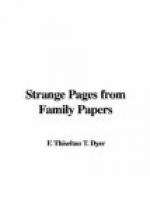Then there is the well-known English tradition relating to Eden Hall, where an old painted drinking-glass is preserved, the property of Sir George Musgrave of Edenhall, in Cumberland, in the possession of whose family it has been for many generations. The tradition is that a butler going to draw water from a well in the garden, called St. Cuthbert’s well, came upon a company of fairies at their revels, and snatched it from them. They did all they could to recover their ravished property, but failing, disappeared after pronouncing the following prophecy:
If this glass do break or
fall
Farewell the luck of Edenhall.
So long, therefore, runs the legendary tale, as this drinking glass is preserved, the “luck of Edenhall” will continue to exist, but should ever the day occur when any mishap befalls it, this heirloom will instantly become an unlucky possession in the family. The most recent account of this cup appeared in The Scarborough Gazette in the year 1880, in which it was described as “a glass stoup, a drinking vessel, about six inches in height, having a circular base, perfectly flat, two inches in diameter, gradually expanding upwards till it ends in a mouth four inches across. The general hue is a warm green, resembling the tone known by artists as brown pink. Upon the transparent glass is traced a geometric pattern in white and blue enamel, somewhat raised, aided by gold and a little crimson.” The earliest mention of this curious relic seems to have been made by Francis Douce, who was at Edenhall in the year 1785, and wrote some verses upon it, but there does not seem to be any authentic family history attaching to it.




